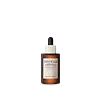What's inside
What's inside
 Key Ingredients
Key Ingredients

 Benefits
Benefits

 Concerns
Concerns

 Ingredients Side-by-side
Ingredients Side-by-side

Water
Skin ConditioningSqualane
EmollientIsoamyl Laurate
EmollientPropanediol
SolventGalactomyces Ferment Filtrate
HumectantPotassium Azeloyl Diglycinate
Skin ConditioningSaccharide Isomerate
HumectantNiacinamide
SmoothingInulin
Skin ConditioningMaltodextrin
AbsorbentSodium Carboxymethyl Beta-Glucan
CleansingPolyglyceryl-6 Behenate
Emulsion StabilisingPolyglyceryl-6 Stearate
EmollientZymomonas Ferment Extract
HumectantHoney Extract
HumectantAllantoin
Skin ConditioningGlyceryl Stearate
EmollientDehydroacetic Acid
PreservativeBenzyl Alcohol
PerfumingDipropylene Glycol
HumectantPentylene Glycol
Skin ConditioningXanthan Gum
EmulsifyingCitric Acid
BufferingSodium Citrate
BufferingLactic Acid
BufferingWater, Squalane, Isoamyl Laurate, Propanediol, Galactomyces Ferment Filtrate, Potassium Azeloyl Diglycinate, Saccharide Isomerate, Niacinamide, Inulin, Maltodextrin, Sodium Carboxymethyl Beta-Glucan, Polyglyceryl-6 Behenate, Polyglyceryl-6 Stearate, Zymomonas Ferment Extract, Honey Extract, Allantoin, Glyceryl Stearate, Dehydroacetic Acid, Benzyl Alcohol, Dipropylene Glycol, Pentylene Glycol, Xanthan Gum, Citric Acid, Sodium Citrate, Lactic Acid
Centella Asiatica Extract
CleansingButylene Glycol
HumectantGlycerin
HumectantWater
Skin ConditioningPropanediol
SolventCaprylic/Capric Triglyceride
MaskingNiacinamide
SmoothingLactobacillus/Centella Asiatica Extract Ferment Filtrate
Skin Conditioning1,2-Hexanediol
Skin ConditioningDipropylene Glycol
HumectantPolyglyceryl-3 Distearate
EmulsifyingAcrylates/C10-30 Alkyl Acrylate Crosspolymer
Emulsion StabilisingC14-22 Alcohols
Emulsion StabilisingArginine
MaskingHydrogenated Lecithin
EmulsifyingBetaine
HumectantAllantoin
Skin ConditioningPanthenol
Skin ConditioningHydroxystearic Acid
CleansingEthylhexylglycerin
Skin ConditioningHydroxyethyl Acrylate/Sodium Acryloyldimethyl Taurate Copolymer
Emulsion StabilisingGlyceryl Stearate Citrate
EmollientSodium Polyacrylate
AbsorbentAdenosine
Skin ConditioningC12-20 Alkyl Glucoside
EmulsifyingCetearyl Alcohol
EmollientXanthan Gum
EmulsifyingMacadamia Ternifolia Seed Oil
EmollientSodium Phytate
Sodium Hyaluronate
HumectantStearic Acid
CleansingCeramide NP
Skin ConditioningGlyceryl Acrylate/Acrylic Acid Copolymer
HumectantSorbitan Isostearate
EmulsifyingPolyglyceryl-10 Myristate
Skin ConditioningMadecassic Acid
Skin ConditioningAsiaticoside
AntioxidantPhytosphingosine
Skin ConditioningAsiatic Acid
Skin ConditioningSucrose Distearate
EmollientPolyglutamic Acid
Skin ConditioningGlucose
HumectantLauric Acid
CleansingPhytosterols
Skin ConditioningCentella Asiatica Extract, Butylene Glycol, Glycerin, Water, Propanediol, Caprylic/Capric Triglyceride, Niacinamide, Lactobacillus/Centella Asiatica Extract Ferment Filtrate, 1,2-Hexanediol, Dipropylene Glycol, Polyglyceryl-3 Distearate, Acrylates/C10-30 Alkyl Acrylate Crosspolymer, C14-22 Alcohols, Arginine, Hydrogenated Lecithin, Betaine, Allantoin, Panthenol, Hydroxystearic Acid, Ethylhexylglycerin, Hydroxyethyl Acrylate/Sodium Acryloyldimethyl Taurate Copolymer, Glyceryl Stearate Citrate, Sodium Polyacrylate, Adenosine, C12-20 Alkyl Glucoside, Cetearyl Alcohol, Xanthan Gum, Macadamia Ternifolia Seed Oil, Sodium Phytate, Sodium Hyaluronate, Stearic Acid, Ceramide NP, Glyceryl Acrylate/Acrylic Acid Copolymer, Sorbitan Isostearate, Polyglyceryl-10 Myristate, Madecassic Acid, Asiaticoside, Phytosphingosine, Asiatic Acid, Sucrose Distearate, Polyglutamic Acid, Glucose, Lauric Acid, Phytosterols
 Reviews
Reviews

Ingredients Explained
These ingredients are found in both products.
Ingredients higher up in an ingredient list are typically present in a larger amount.
Allantoin is a soothing ingredient known for its protective and moisturizingg properties. Because of this, it is often added to products with strong active ingredients.
Studies show higher concentrations of this ingredient can promote wound healing.
Though it can be derived from the comfrey plant, allantoin is produced synthetically for cosmetic products to ensure purity.
Learn more about AllantoinDipropylene Glycol is a synthetically created humectant, stabilizer, and solvent.
This ingredient helps:
Dipropylene glycol is technically an alcohol, but it belongs to the glycol family (often considered part of the ‘good’ alcohols). This means it is hydrating and gentle on skin unlike drying solvent alcohols like denatured alcohol.
As a masking agent, Dipropylene Glycol can be used to cover the smell of other ingredients. However, it does not have a scent.
Studies show Dipropylene Glycol is considered safe to use in skincare.
Learn more about Dipropylene GlycolNiacinamide is a multitasking form of vitamin B3 that strengthens the skin barrier, reduces pores and dark spots, regulates oil, and improves signs of aging.
And the best part? It's gentle and well-tolerated by most skin types, including sensitive and reactive skin.
You might have heard of "niacin flush", or the reddening of skin that causes itchiness. Niacinamide has not been found to cause this.
In very rare cases, some individuals may not be able to tolerate niacinamide at all or experience an allergic reaction to it.
If you are experiencing flaking, irritation, and dryness with this ingredient, be sure to double check all your products as this ingredient can be found in all categories of skincare.
When incorporating niacinamide into your routine, look out for concentration amounts. Typically, 5% niacinamide provides benefits such as fading dark spots. However, if you have sensitive skin, it is better to begin with a smaller concentration.
When you apply niacinamide to your skin, your body converts it into nicotinamide adenine dinucleotide (NAD). NAD is an essential coenzyme that is already found in your cells as "fuel" and powers countless biological processes.
In your skin, NAD helps repair cell damage, produce new healthy cells, support collagen production, strengthen the skin barrier, and fight environmental stressors (like UV and pollution).
Our natural NAD levels start to decline with age, leading to slower skin repair, visible aging, and a weaker skin barrier. By providing your skin niacinamide, you're recharging your skin's NAD levels. This leads to stronger, healthier, and younger looking skin.
Another name for vitamin B3 is nicotinamide. This vitamin is water-soluble and our bodies don't store it. We obtain Vitamin B3 from either food or skincare. Meat, fish, wheat, yeast, and leafy greens contain vitamin B3.
The type of niacinamide used in skincare is synthetically created.
Learn more about NiacinamidePropanediol is an all-star ingredient. It softens, hydrates, and smooths the skin.
It’s often used to:
Propanediol is not likely to cause sensitivity and considered safe to use. It is derived from corn or petroleum with a clear color and no scent.
Learn more about PropanediolWater. It's the most common cosmetic ingredient of all. You'll usually see it at the top of ingredient lists, meaning that it makes up the largest part of the product.
So why is it so popular? Water most often acts as a solvent - this means that it helps dissolve other ingredients into the formulation.
You'll also recognize water as that liquid we all need to stay alive. If you see this, drink a glass of water. Stay hydrated!
Learn more about WaterXanthan gum is used as a stabilizer and thickener within cosmetic products. It helps give products a sticky, thick feeling - preventing them from being too runny.
On the technical side of things, xanthan gum is a polysaccharide - a combination consisting of multiple sugar molecules bonded together.
Xanthan gum is a pretty common and great ingredient. It is a natural, non-toxic, non-irritating ingredient that is also commonly used in food products.
Learn more about Xanthan Gum